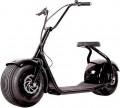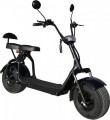Range
The range of a vehicle is the distance it can travel on a single battery charge.
Note that the range usually indicates the value for perfect operating conditions: driving at optimal speed with a small load, flat road, no ups and downs, etc. The actual range may differ from the claimed one, sometimes quite noticeably. In addition, to improve range, manufacturers can deliberately use low-power motors that consume little energy.
Max speed
The highest speed that a vehicle can reach.
When choosing according to this parameter, it is worth considering that in dense city traffic, it is rarely possible to accelerate faster than 40 km/h; so if the vehicle is bought mainly for a comfortable ride through traffic jams, then there is no need to look for a high-speed model. In addition, for the same motor power, low speed means more torque, which makes it easier to climb hills.
Wheel size
tThe diameter of the wheels used in the vehicle. For models with wheels of different sizes, the largest diameter is usually indicated, other data can be specified in the notes.
For electric scooterbikes, the traditional size is a modest 10"; larger sizes are also found — up to
16". Among minibikes, large
18" wheels are more common. Electric motorcycles have small wheels — an average of 12 – 14". Among electric tricycles, a combination of a large front wheel with small rear wheels is often found — for example, 16 "and 4" each, respectively.
The large diameter allows you to roll over the bumps on the road, overcome rather large obstacles and maintain speed longer when coasting; on the other hand, such wheels require more torque from the engine, they accelerate worse and reduce the maximum speed of the unit. Small wheels, on the contrary, accelerate well and also provide good manoeuvrability, but they are intended mainly for flat roads.
Clearance
Vehicle clearance.
Clearance is the distance from the ground to the lowest point of the vehicle (excluding wheels). Roughly speaking, this is the highest height of an object that can fit under the vehicle without being hit the body.
The higher the clearance — the higher the obstacles that the unit can cope with, the lower the likelihood that when overcoming another pothole or bump, the body will touch the ground. On the other hand, low ground clearance lowers the centre of gravity and improves overall stability; so for roads with high-quality pavement and other flat surfaces, it is the smaller clearance that is considered optimal.
Wheelbase
Wheelbase of the vehicle.
This term shows the distance between the wheels, more precisely, between the axles of the wheels. This size is one of the key parameters for any motorcycle, it determines not only the overall dimensions of the vehicle but also some of the features of the movement. So, a small wheelbase reduces the turning radius and makes the vehicle more manoeuvrable; at the same time, a longer vehicle will be more stable and predictable in corners.
More features
Additional features provided in the design of the vehicle.
—
Headlight and position lamps. Lighting devices are designed to ensure safety at night and in conditions of low visibility. Position lamps are used to highlight the vehicle on the road, the headlight can also perform this function, but its main task is to illuminate the road in front of the vehicle. In most countries, traffic rules prohibit driving on roads in the evening and at night without headlights and headlight and position lamps. Note that such lighting devices can be purchased and installed separately. However, it is easier to immediately purchase transport, where it was originally provided.
—
Turn signals. Standard turn signals are yellow or orange and are installed on both sides of the unit. Recall that according to the rules, it is necessary to indicate turns and lane changes; without light indicators, such signals have to be given by hand, removing it from the handlebar — which is not very convenient, and sometimes unsafe. Turn signals also simplify the task — to turn on the signal, just press a button or slide a switch.
—
Horn. Special sound signal. The sound signal is intended primarily to warn other road users and prevent accidents.
— Anti-theft system. Security system to prevent vehicle theft. Note that the specific way the anti-theft system works in
...different models may be different, it should be specified separately. In some cases, it is limited to notifications sent to the key fob or mobile phone that the thief is trying to move the vehicle. In other devices, the protection system can physically prevent theft — for example, by locking the steering or brakes.
— Carrier. Only containers installed in the rear of the vehicle are referred to as the carrier — a basket on the handlebar can be used in the front (see the relevant paragraph).
— Handlebar basket. A small basket is located on the handlebar of a vehicle. It is similar to the carrier (see the relevant paragraph) and is intended for the transport of various items. However, note that it is impossible to carry a lot of weight on the handlebar, this worsens stability and manoeuvrability. However, baskets usually have a small volume anyway.
— Kickstand. It is a small stand in the lower part of the body, which is laid out during parking and allows the unit to stand stably in an upright position. This function is relevant only for two-wheeled vehicles.
— Pedals. In this case, we are talking about pedals like bicycle pedals, which are placed under the driver's feet. This feature can be extremely useful in emergencies — for example, if the battery was forgotten to be charged or it discharged in the middle of the trip, if there was a malfunction in the electronics, or if it is far from charging and the battery needs to be saved. Another way to use the pedals is to assist the motor in difficult conditions, such as when driving through mud or on a steep slope.
Note that pedals are not used in minibikes — not because of difficulties of installation, but as unnecessary: in extreme cases, you can ride on such transport like on a kick scooter, pushing off the ground with your foot.Power
The motor power of a vehicle, in horsepower.
In general, the power of electric motors is indicated in watts. However, in electric transport, this designation is also often indicated. This is done for the convenience of comparison with internal combustion engines: for internal combustion engines, especially in vehicles, horsepower is traditionally used, and it is more convenient for some users to evaluate the power of motors by this designation. At the same time, if the need arises, some units are easily converted to others: 1 hp. ≈ 735 W.
For the power value in general, see the relevant paragraph below.
Power
The motor power of a vehicle, in kilowatts. In addition to them, horsepower is also used (for more details, see above).
Let us clarify that in this case, we are talking about
maximum power; the actual power can be adjusted while driving with the help of the accelerator. And in some models, it may even be possible to set a limit on the maximum power.
A more powerful motor allows you to carry more weight, reach higher speeds and/or have more torque. However, the energy consumption from the battery will also be high, and the battery life, with the same battery capacity, will be correspondingly less than when using a less powerful motor. Also note that in many countries, motor power is a criterion for classifying an electric vehicle as one or another variety. For example, according to this criterion, motorcycles and scooters can be formally separated, requiring different driving licences.
Battery capacity
The capacity of the battery installed in the vehicle, in ampere-hours.
Theoretically, the battery life of the vehicle directly depends on this parameter: a more capacious battery can supply the electric motor longer. However, the actual amount of stored energy depends not only on the capacity in amp-hours but also on the nominal voltage of the battery. A more correct unit in this sense is watt-hours, taking into account the difference in nominal voltages; see "Battery capacity" below for details on this designation. Additionally, the operating time on a charge will depend not only on the characteristics of the battery but also on the power consumption of the vehicle itself — and it is determined by the motor power and several other parameters.

